Dear readers, do you know that Filipino dishes were ranked by TasteAtlas1? See the photo below for the best and worst ranked dishes, based on reviews and ratings by TasteAtlas users. For foreign readers, allow Tita S to tell you about the dish which was ranked the highest of all Filipino dishes – Lumpiang Shanghai.
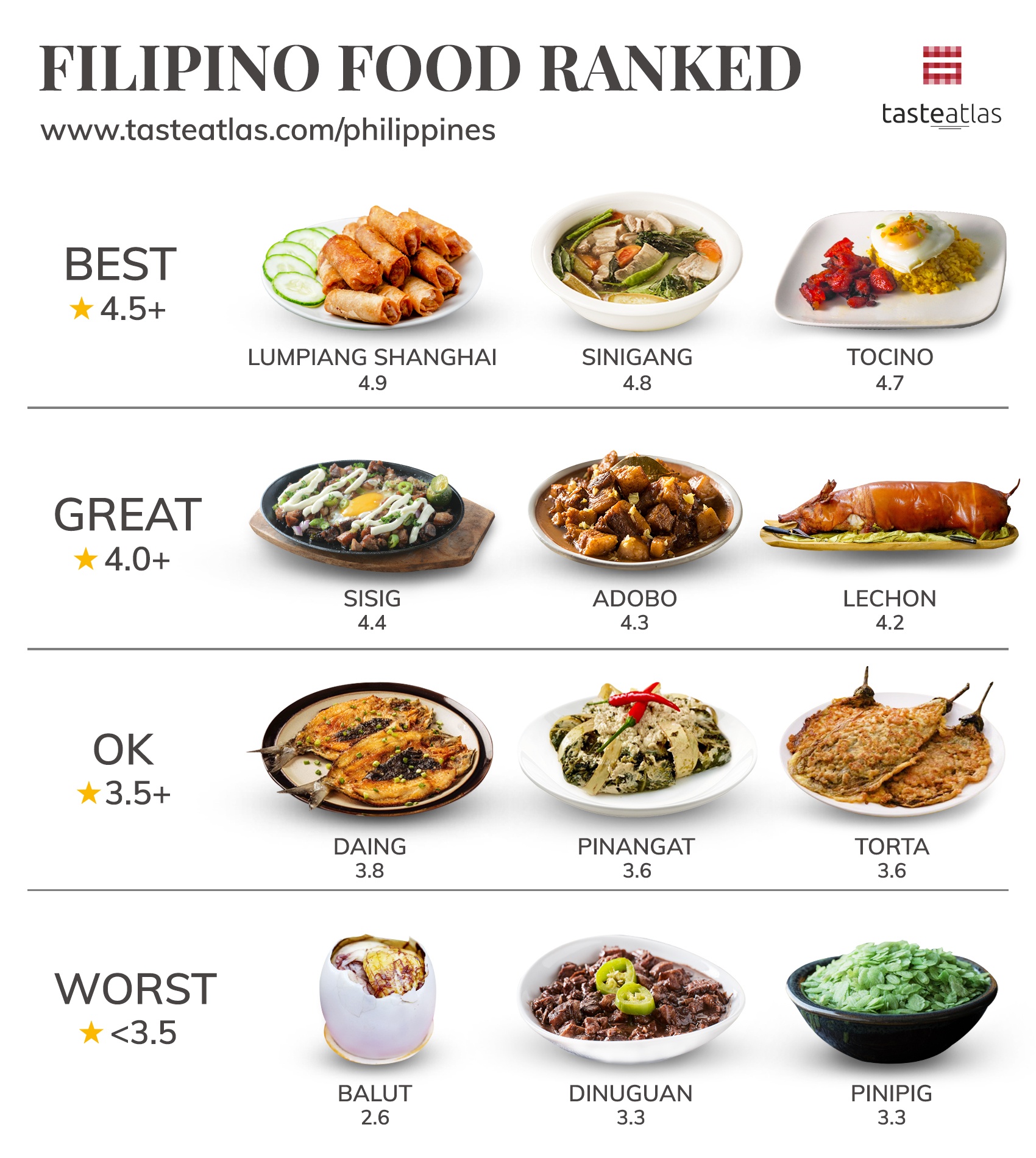
Filipino Food Ranked, Taste Atlas, 2021 – Photo source: https://www.facebook.com/TasteAtlas/photos/a.1929025990666428/3057055454530137/
1.Lumpiang shanghai, or Shanghai roll, is a Filipino, crispy, deep-fried spring roll (lumpia2 in Filipino), served as an appetizer or main dish, which consists of a savory mixture of ground pork (giniling na baboy) sauteed with finely chopped carrots, garlic, onion, shallots, seasoned with salt and pepper. Sometimes, the mixture is further moistened with a raw, beaten egg as a binding agent to retain its shape better.
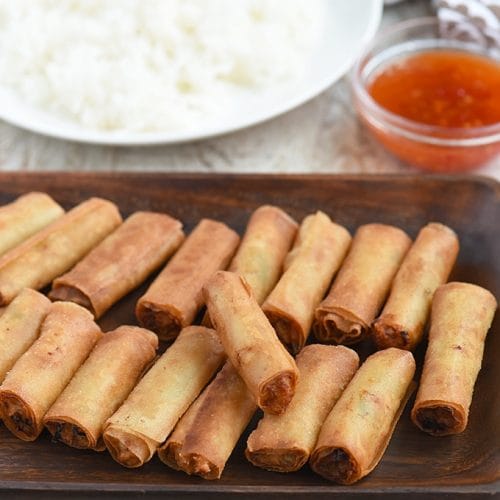
Photo source: https://www.facebook.com/photo/fbid=111684677357048&set=a.111684714023711
2. A small amount of the cooled mixture is wrapped in a thin crepe (lumpia2 wrapper3), rolled like a thin cylinder, the ends secured with a bit of water or egg white.
3. It is commonly prepared ahead of time, stored in the freezer, and only deep-fried until golden brown just before serving for its appealing crispy texture.
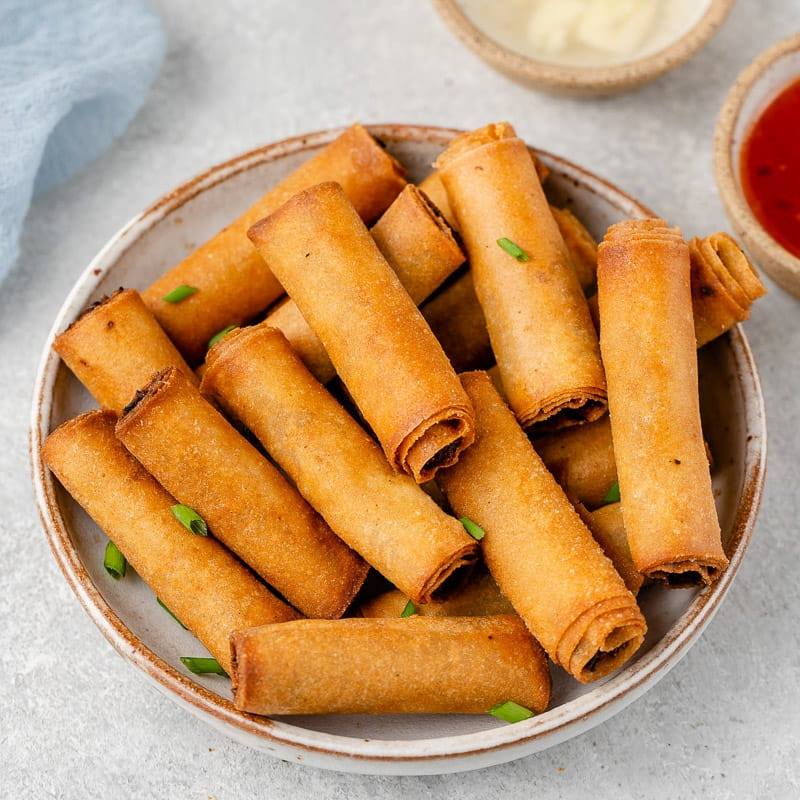
Photo source: https://www.facebook.com/photo/fbid=111685517356964&set=a.111685534023629
4. It is smaller and thinner than other Filipino lumpia2 variants. It is considered the Filipino version of a taquito4 but resembles more the Chinese spring roll.
5. It is served hot or warm, with a dipping sauce like sweet and sour sauce, sweet chili sauce, banana ketchup, vinegar with labuyo peppers (Philippine hot chili peppers) and calamansi (Philippine lime) juice, or garlic mayonnaise.
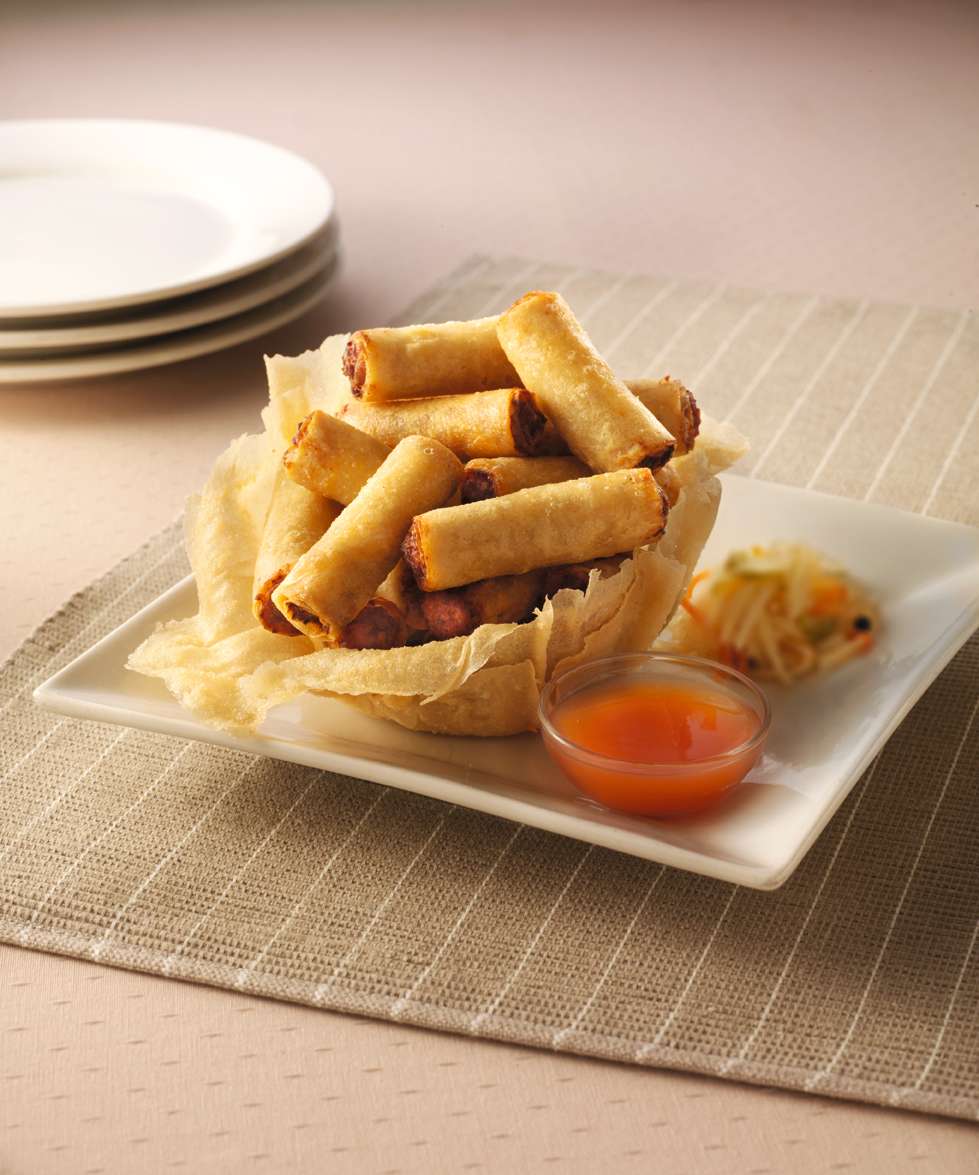
Lumpiang Shanghai, Max’s Restaurant, Bloomfield, New Jersey – Photo source: https://www.maxsrestaurantna.com/items/lumpiang-shanghai
6. There are many variations of Lumpiang Shanghai, depending on the desired filling-mixture. Some use ground beef, ground shrimp, shredded chicken, a combination of ground pork and beef, green peas, raisins, bell peppers, milk, water chestnuts (apulid), jicama (singkamas) and Chinese celery (kinchay), among others.
7. It is a staple dish served during special and festive occasions in the Philippines.
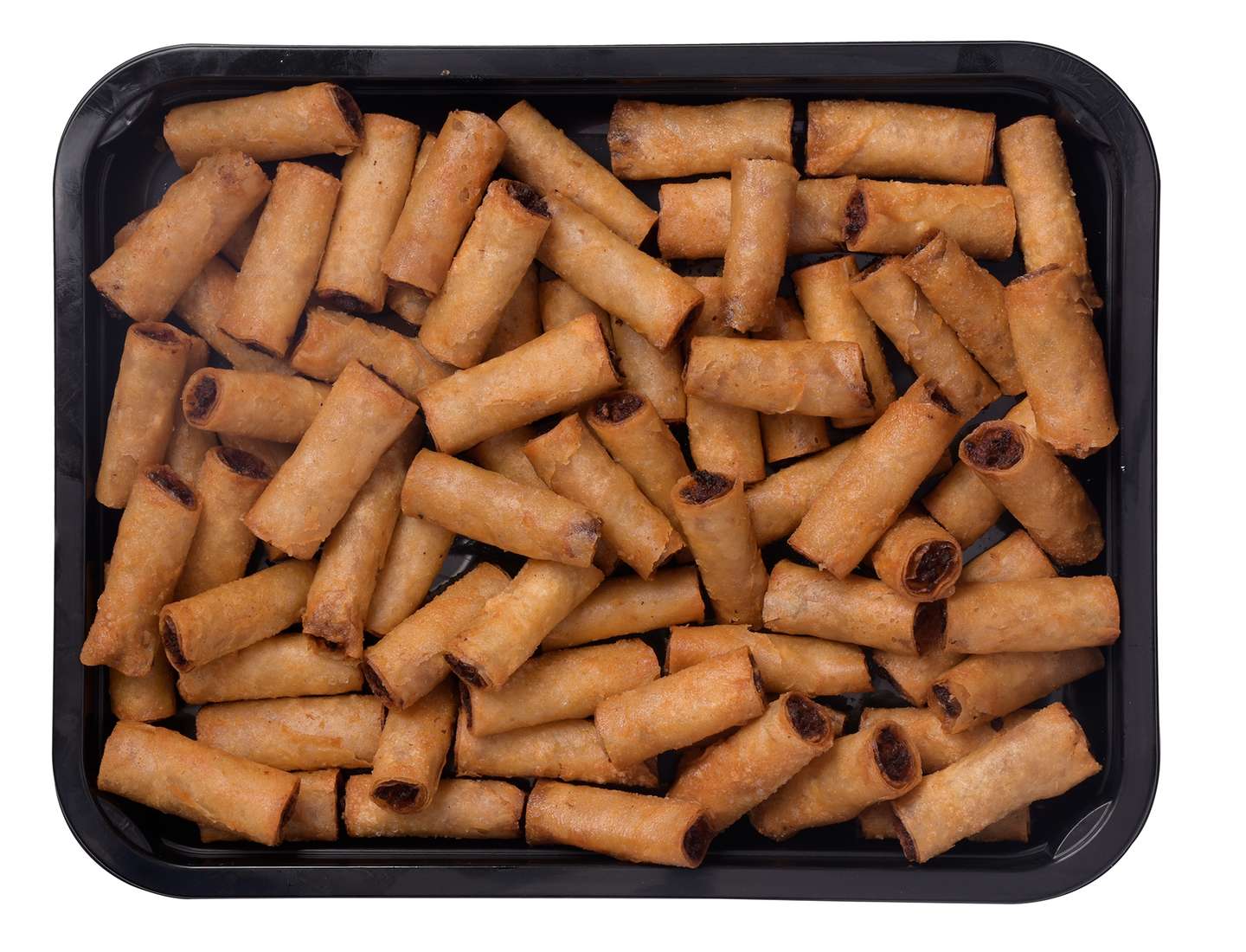
Lumpiang shanghai sold by the tray, Max’s Restaurant, Las Vegas, USA – Photo source: https://www.maxsrestaurantna.com/items/lumpiang-shanghai-2
8. No, this dish did not originate from Shanghai or any part of China. The early version of its wrap was made of tortilla fried just before serving until golden brown. Tortilla, chosen for its appealing crispy texture, was made from Spanish corn flour, masa5, until Chinese migrants introduced their own version of a wrapper made from rice flour during the early Spanish colonial era (sometime during the 1520s). However, the Filipinos made a thinner wrapper compared to the Chinese spring roll wrapper.
9. As I mentioned earlier, Lumpiang Shanghai topped the list of highly-rated Filipino food by TasteAtlas1 in September 2021, based on reviews and ratings of culinary professionals and diners worldwide, using this scale:
* Best – 4.5 stars and above
* Great – 4.0 to 4.4 stars
* OK – 3.5 to 3.9 stars
* Worst – less than 3.5 stars
Guess what? Lumpiang Shanghai got a score of 4.9. The rest, with their lower scores, are featured in the topmost photo of this post. Well, what do you think, dear readers, do you agree with this survey?
The information was obtained from https://www.tasteatlas.com/lumpiang-shanghai, https://news.abs-cbn.com/life/09/10/21/lumpiang-shanghai-is-top-filipino-food-on-tasteatlas, https://mb.com.ph/2021/09/10/lumpiang-shanghai-is-best-filipino-food-according-to-taste-atlas/, https://www.yummy.ph/news-trends/taste-atlas-filipino-food-ranked-lumpiang-shanghai-dinuguan-a00260-20210910, https://philstarlife.com/living/123613-best-filipino-food-tasteatlas and the Wikipedia page “Lumpiang Shanghai”6.
The photo featured in the cover photo-collage was obtained from https://www.facebook.com/104224098275705/photos/a.104224218275693/104224614942320/.
Now for a very brief sharing of Tita S: she loves Lumpiang Shanghai served warm (not hot) so she can easily bite into it. She enjoys the crispy fried lumpia wrapper with every bite. The tasty, savory filling is complemented by a sweet-sour sauce, whether as an appetizer or a treat on a buffet table during special occasions.
No wonder it is appreciated worldwide, also by Hollywood celebrities like Cameron Diaz, Drew Barrymore, Florence Pugh, and rapper Cardi B. Foreign readers, how about you?
This is not a sponsored post. I just want my readers to know more about the Philippines.
Did you find this post informative? I would like to hear your comment/s regarding Lumpiang Shanghai, especially if you were able to taste it.
See other interesting posts in this category (Pinoy Delights) and other categories – SCapades and Smart Travelers – Foreign Travelers Ask, Now You Know, and Say, Say, Say. Happy reading, and I hope that you will appreciate what I shared and some of the featured destinations will be part of your future travel plans!
Remember to share this post with your Facebook friends, follow me by clicking on the bottom right corner of your device, and do not forget to like this post. Thank you.
– – – – – – – – – – – – – – – – – – – – – – – – – –
The following terms are defined for interested readers, especially those with “Senior-Moments”, those not familiar with Filipino terms, and those too busy or lazy to Google such terms:
1TasteAtlas is an online world atlas of traditional food, local ingredients, and authentic restaurants. It features an interactive global food map with dish icons shown in their respective regions, and has nearly 10,000 dishes, drinks and ingredients, as well as 9,000 restaurants, with “dozens of thousands yet to be researched and mapped, the popular ones, as well as the forgotten tastes and aromas of every city, region and village in the world”. This food guide collates authentic recipes, food critic reviews and research articles about popular ingredients and dishes.
This site uses reviews and recommendations from gastronomy professionals and critics, instead of user-generated content, citing trustworthiness as the main reason. It is a recommended curriculum resource in several education systems, such as those in Ireland, and Kansas, USA.
For example, if you go to its website, you can type Philippines in the box provided, and it will reveal 167 dishes all around the country (with your search choice – alphabetically, by location, rating or popularity), provide an overview for each item with a photo and recipe (with cooking tips), and even show you where to try them.
It was founded by Croatian journalist and entrepreneur Matija Babic in 2015 and its headquarters is located in Sofia, Bulgaria. However, it took 3 years of research and development before the project launch in late 2018. It received an honorable mention in the 2018 Awwwards, a yearly professional web design and development competition. Visit its website: https://www.tasteatlas.com.
It also hands out TasteAtlas Awards for categories like “Best Traditional Dish”, “Best Cuisine” and “Best Traditional Food City”.
It encounters issues like dishes contested among multiple countries and similar dishes with several regional names. In the case of the lack of any trustworthy information, the dish is not included on the list.
The information was obtained from https://philstarlife.com/living/123613-best-filipino-food-tasteatlas and the Wikipedia page “TasteAtlas”7.
2Lumpia is the Filipino term for spring roll. It is a savory dish made with a thin crepe pastry skin called lumpia wrapper3 enveloping a mixture of savory fillings consisting of chopped vegetables (e.g., bamboo shoots, cabbage, carrot, green beans, leeks), or sometimes also minced meat (beef, chicken, pork and shrimp). It is often served as an appetizer or snack, and could be served either deep fried or fresh (unfried). The information was obtained from the Wikipedia page “Lumpia”.8
3The Filipino lumpia wrapper is used to wrap different kinds of lumpia2 in the country. There are two kinds:
* the paper-thin wrapper for fried lumpia made of flour, water, salt, and (optionally) cornstarch – This is the most common kind which is thinner than other spring roll wrappers. The mixture looks like a wet dough left to stand for a few hours before cooking. It is traditionally made manually, where a ball of dough is taken with one hand and smeared into a heated large flat metal plate, greased with oil, until a very thin circular film adheres to the heated surface and fries. It is cooked for a few seconds, and quickly take out when the sides start to curl, and left to dry. It can be mass produced similar to those used to make spring roll wrappers.
*the soft wrapper for fresh lumpia (Lumpiang Sariwa) made with flour, water, salt and egg – This is a thin egg crepe, still thinner than other spring roll variants, but thicker than the first kind, and delightfully soft to complement the various textures of the filling and the viscous-sweetish sauce.
The paper-thin wrapper (for fried lumpia) can also be used to wrap saba9 bananas to make a favorite Filipino fried snack, turon10.
The information was obtained from the Wikipedia page “Lumpia”.8
4A taquito, flauta (“flute”), rolled taco, or tacos dorados (“golden taco”), is a deep-fried Mexican dish which consists of a small rolled-up tortilla that contains a filling made of beef, cheese or chicken, topped with condiments such as sour cream and guacamole.
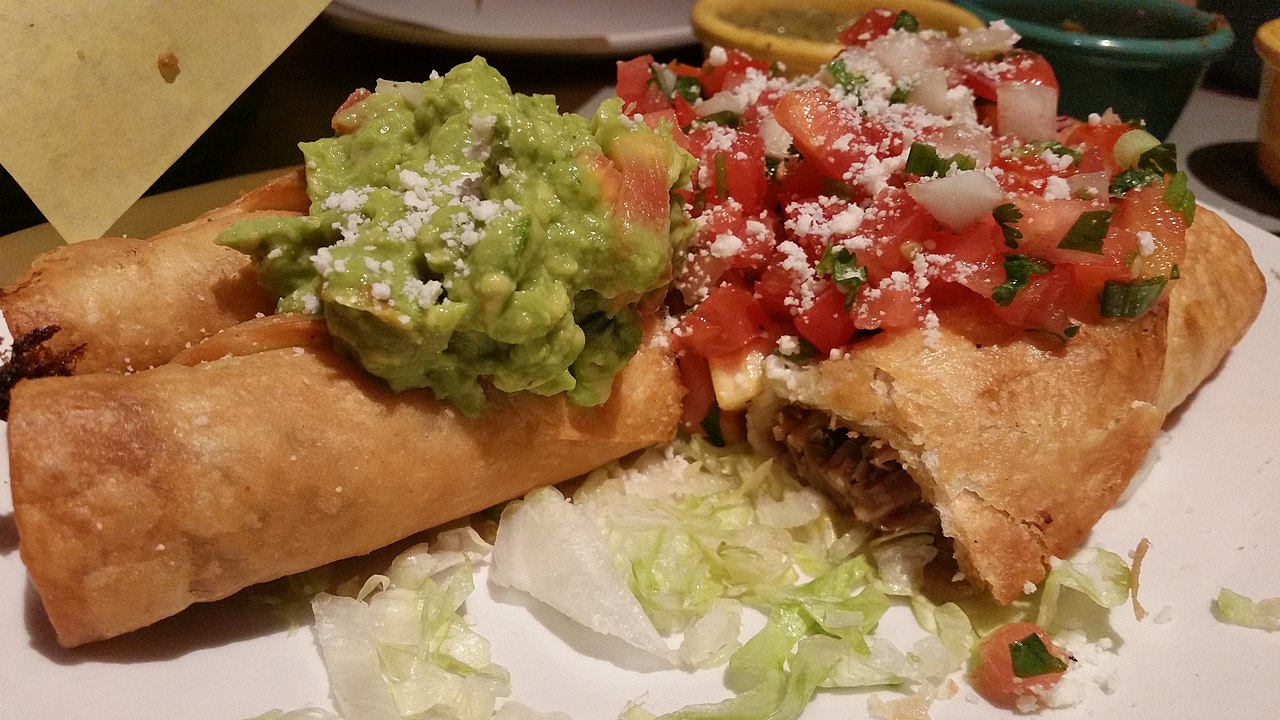
A taquito called Carnitas Flautas, served with jack cheese, guacamole, salsa fresca and cotija cheese – Photo source: RightCowLeftCoast, own work, CC BY-SA 4.0, created 4 June 2018, https://en.wikipedia.org/wiki/Taquito#/media/File:Carnitas_flautas.jpg
Corn tortillas are generally used to make taquitos. Larger taquitos are called flautas, and can be made with either flour or corn tortillas. Typical toppings of tacos dorados include cabbage, crema (Mexican sour cream), guacamole, green chili or red chili salsa, and crumbled Mexican cheese such as queso fresco (“white cheese”).
The information was obtained from the Wikipedia page “Taquito”.11
5Masa, or masa de maiz, is a maize dough made of ground nixtamalized12 corn used to make many Latin American dishes such corn tortillas, gorditas, pupusas, and tamales.
The flour’s dried and powdered form is called masa harina (“dough flour”). This flour is reconstituted with water to make a dough before it is used in cooking.
The information was obtained from the Wikipedia page “Masa”.13
6“Lumpiang Shanghai” accessed September 13, 2021, https://en.wikipedia.org/wiki/Lumpiang_Shanghai
7“TasteAtlas” accessed September 13, 2021, https://en.wikipedia.org/wiki/TasteAtlas
8“Lumpia,” accessed November 30, 2020, https://en.wikipedia.org/wiki/Lumpia
9Saba banana is a squarish and angular type of banana originating from the Philippines and is widely used in its cuisine. It is basically a cooking banana, though it may also be eaten raw.
The fruit is 8 to 13 cm (3.1 to 5.1 in) long and 2.5 to 5.5 cm (0.98 ro 2.17 in) in diameter. It provides the same nutritional value as potatoes.
The flesh is white and starchy so it is ideal for cooking various traditional Filipino desserts and dishes. It is also used to make banana ketchup. It is likewise popular in Indonesia, Malaysia, and Singapore.
Do you know that each bunch of saba typically has 18 hands, with each hand having 12 to 20 fingers, and it takes 150 to 180 days after flowering before they can be harvested (while still green), and transported over long distances? That makes it longer than other banana varieties.
The information was obtained from the Wikipedia page “Saba banana”.14
10Turon, or lumpiang saging (Filipino for “banana lumpia2”) is a Philippine snack, sold as a street-food, and is made of thinly sliced saba9 bananas, dusted with brown sugar, rolled in a spring roll wrapper, and fried. Fillings may be added, together with the saba, usually ripe jackfruit (langka), sweet potato (kamote), mango, cheddar cheese, or coconut. The information was obtained from the Wikipedia page “Turon (food)”.15
11“Taquito” accessed September 13, 2021, https://en.wikipedia.org/wiki/Taquito
12Nixtamalization is a process for the preparation of corn (maize), or other grains, in which corn is soaked and cooked in an alkaline solution, usually limewater, washed, and then hulled. This process removes up to 97-100% of aflatoxins from mycotoxin-contaminated corn. Other benefits of this process includes: the grain is more easily ground and allows dough formation, the nutritional value is increased, the flavor and aroma are improved. It is used to make hominy, tamales, tortillas, tortilla chips, among others.
Nixtamalization also refers to the removal of the pericarp from other grains, like sorghum, via an alkali process.
The information was obtained from the Wikipedia page “Nixtamalization”.16
13“Masa” accessed September 13, 2021, https://en.wikipedia.org/wiki/Masa
14“Saba banana,” accessed May 11, 2018, https://en.wikipedia.org/wiki/Saba_banana
15“Turon (food),” accessed May 11, 2018, https://en.wikipedia.org/wiki/Turon_(food)
16“Nixtamalization” accessed September 13, 2021, https://en.wikipedia.org/wiki/Nixtamalization

